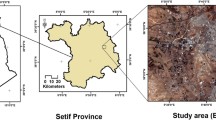Abstract
In this paper, a new method was investigated to enhance remote sensing images by alleviating the point spread function (PSF) effect. The PSF effect exists ubiquitously in remotely sensed imagery. As a result, image quality is greatly affected, and this imposes a fundamental limit on the amount of information captured in remotely sensed images. A geostatistical filter was proposed to enhance image quality based on a downscaling-then-upscaling scheme. The difference between this method and previous methods is that the PSF is represented by breaking the pixel down into a series of sub-pixels, facilitating downscaling using the PSF and then upscaling using a square-wave response. Thus, the sub-pixels allow disaggregation as an attempt to remove the PSF effect. Experimental results on simulated and real data sets both suggest that the proposed filter can enhance the original images by reducing the PSF effect and quantify the extent to which this is possible. The predictions using the new method outperform the original coarse PSF-contaminated imagery as well as a benchmark method. The proposed method represents a new solution to compensate for the limitations introduced by remote sensors (i.e., hardware) using computer techniques (i.e., software). The method has widespread application value, particularly for applications based on remote sensing image analysis.









Similar content being viewed by others
References
Campagnolo ML, Montano EL (2014) Estimation of effective resolution for daily MODIS gridded surface reflectance products. IEEE Trans Geosci Remote Sens 52:5622–5632
Cao G, Zhao Y, Ni R, Kot AC (2011) Unsharp masking sharpening detection via overshoot artifacts analysis. IEEE Signal Process Lett 18:603–606
Farbiz F, Menhaj MB, Motamedi SA, Hagan MT (2000) A new fuzzy logic filter for image enhancement. IEEE Trans Syst Man Cybern Part B Cybern 30:110–119
Gilboa G, Sochen N, Zeevi YY (2002) Forward-and-backward diffusion processes for adaptive image enhancement and denoising. IEEE Trans Image Process 11:689–703
Huang C, Townshend RG, Liang S, Kalluri SNV, DeFries RS (2002) Impact of sensor’s point spread function on land cover characterization: assessment and deconvolution. Remote Sens Environ 80:203–212
Kaiser G, Schneider W (2008) Estimation of sensor point spread function by spatial subpixel analysis. Int J Remote Sens 29:2137–2155
Kim S, Allebach JP (2005) Optimal unsharp mask for image sharpening and noise removal. J Electron Imaging 14:023007
Kükenbrink D, Hueni A, Schneider FD, Damm A, Gastellu-Etchegorry J-P, Schaepman ME, Morsdorf F (2019) Mapping the irradiance field of a single tree: quantifying vegetation-induced adjacency effects. IEEE Trans Geosci Remote Sens 57:4994–5011
Kyriakidis PC (2004) A geostatistical framework for area-to-point spatial interpolation. Geogr Anal 36:259–289
Kyriakidis P, Yoo E-H (2005) Geostatistical prediction and simulation of point values from areal data. Geogr Anal 37:124–151
Manslow JF, Nixon MS (2002) On the ambiguity induced by a remote sensor’s PSF. In: Foody GM, Atkinson PM (eds) Uncertainty in remote sensing and GIS. Wiley, New York, pp 37–57
Matz SC, de Figueiredo RJP (2006) A nonlinear image contrast sharpening approach based on Munsell’s scale. IEEE Trans Image Process 15:900–909
Pardo-Iguzquiza E, Chica-Olmo M, Atkinson PM (2006) Downscaling cokriging for image sharpening. Remote Sens Environ 102:86–98
Polesel A, Ramponi G, Mathews VJ (2000) Image enhancement via adaptive unsharp masking. IEEE Trans Image Process 9:505–510
Ramponi G, Strobel N, Mitra SK, Yu T-H (1996) Nonlinear unsharp masking methods for image contrast enhancement. J Electron Imaging 5:353–366
Tan B, Woodcock CE, Hu J, Zhang P, Ozdogan M, Huang D, Yang W, Knyazikhin Y, Myneni RB (2006) The impact of gridding artifacts on the local spatial properties of MODIS data: implications for validation, compositing, and band-to-band registration across resolutions. Remote Sens Environ 105:98–114
Townshend RG, Huang C, Kalluri SNV, Defries RS, Liang S (2000) Beware of per-pixel characterization of land cover. Int J Remote Sens 21:839–843
Van der Meer FD (2012) Remote-sensing image analysis and geostatistics. Int J Remote Sens 33(18):5644–5676
Vivone G, Alparone L, Chanussot J, Dalla Mura M, Garzelli A, Licciardi GA, Restaino R, Wald L (2015) A critical comparison among pansharpening algorithms. IEEE Trans Geosci Remote Sens 53:2565–2586
Wang Q, Atkinson PM (2017) The effect of the point spread function on sub-pixel mapping. Remote Sens Environ 193:127–137
Wang Q, Shi W, Atkinson PM, Zhao Y (2015) Downscaling MODIS images with area-to-point regression kriging. Remote Sens Environ 166:191–204
Wang Q, Shi W, Atkinson PM (2016) Area-to-point regression kriging for pan-sharpening. ISPRS J Photogramm Remote Sens 114:151–165
Wang Q, Shi W, Atkinson PM (2018) Enhancing spectral unmixing by considering the point spread function effect. Spat Stat 28:271–283
Wang X, Zhong Y, Zhang L, Xu Y (2019) Blind hyperspectral unmixing considering the adjacency effect. IEEE Trans Geosci Remote Sens. https://doi.org/10.1109/TGRS.2019.2907567
Wenny BN, Helder D, Hong J, Leigh L, Thome KJ, Reuter D (2015) Pre- and post-launch spatial quality of the Landsat 8 thermal infrared sensor. Remote Sens 7:1962–1980
Zhang B, Allebach JP (2008) Adaptive bilateral filter for sharpness enhancement and noise removal. IEEE Trans Image Process 17:664–678
Zheng X, Li Z, Zhang X, Shang G (2019) Quantification of the adjacency effect on measurements in the thermal infrared region. IEEE Trans Geosci Remote Sens. https://doi.org/10.1109/TGRS.2019.2928525
Acknowledgements
This work was supported by the National Natural Science Foundation of China under Grant 41971297 and Tongji University under Grants 0250141304 and 02502350047.
Author information
Authors and Affiliations
Corresponding author
Rights and permissions
About this article
Cite this article
Wang, Q., Tong, X. & Atkinson, P.M. A Geostatistical Filter for Remote Sensing Image Enhancement. Math Geosci 52, 317–336 (2020). https://doi.org/10.1007/s11004-019-09829-1
Received:
Accepted:
Published:
Issue Date:
DOI: https://doi.org/10.1007/s11004-019-09829-1




